




SJCMAT’s autumn conference was once again a huge success. This year’s theme was ‘Delivering a world-class Catholic education’ and the Trust welcomed and celebrated staff from across their community.
Well done to all our SJCMAT award winners!







SJCMAT’s autumn conference was once again a huge success. This year’s theme was ‘Delivering a world-class Catholic education’ and the Trust welcomed and celebrated staff from across their community.
Well done to all our SJCMAT award winners!

November is the month of remembrance. It is a time for every one of us to remember our loved ones who have died, especially those who have died as a result of war. As Christians, this is absolutely the right thing to do, because it unites with them in a particular way. By bringing them to mind and asking the Lord to welcome them into his kingdom, we are staying close to them, so that the bonds of love and friendship which united us on earth are not broken but strengthened through prayer. Happy memories are often accompanied by feelings of loss and unrequited grief which make us wonder why there is still so much killing in the world. At the Remembrance Services which take place throughout our nation, our thoughts must turn towards peace.

Peace is not easy to attain. Jesus tells us, “Blessed are the peacemakers for they shall be called children of God”, but even the United Nations peacekeepers are attacked by warring groups. The sadness is that nearly all the participants in the current wars in Europe and the Middle East believe in the same God. The God who created each of us in love. Despite the apparent intractability of the present conflicts, we must continue to work for peace starting with ourselves. By becoming peaceful people ourselves and in our families, we can engender a culture of peace in our society. Confrontation, anger and violence should have no place in our lives. As we remember the Holy Souls in our prayer this month, let us also pray for peace in our lives and in the lives of those we love.
Most Reverend Malcolm McMahon OP Archbishop of Liverpool
The Holy Father’s prayer intentions entrusted to his worldwide prayer network for the year 2024:
Let us pray that all parents who mourn the loss of a son or daughter find support in their community, and may receive peace of heart from the Spirit of Consolation.
www.popesprayer.va
Editor Harriet Anwyl
Editorial Catholic Pictorial Magazine, St Margaret Clitherow Centre, Liverpool Archdiocesan Office, Croxteth Drive, Liverpool L17 1AA Tel: 0151 522 1007 Email: CatholicPic@rcaol.org.uk
Advertising Sales team 0151 709 7567 sales@cpmmmedia.com
Contributor
Katie Parry
Pictures
Nick Fairhurst www.nickfairhurstphotographer.com
Martin Cahill (cahill-photography.com)
Sue Mannings
Website: www.catholicpic.co.uk
Twitter @PicCatholic
Youtube CPMM Media

Contents:
4 Main Feature Hope shines brightly as Professor receives Papal honour
7 Sunday Reflections
8 From the Archives “A shock to all of us” The creation of the Diocese of Lancaster
9 News News from around the archdiocese

Copy deadline December 2024 - Monday 11 November 2024
Subscriptions To take out a subscription please email Kim O’Brien at kim.obrien@cpmmmedia.com or call 0151 709 7567
Distribution Contact Barbara on 07714 814 662
Publisher CPMM Ltd Suite 4 Pacific Chambers, 11-13 Victoria Street, Liverpool L2 5QQ
Ltd.
14 What’s On What’s happening in the archdiocese
15 Cathedral Record
16 Pastoral Ponderings
17 Profile Canon John Power
18 Cathedral Life
27 Animate Youth Ministry
28 Pic Extras Mums the word News from the KSC
30 Dialogue and Unity
“We all have our different church dogmatics and history and ways of understanding faith, but at the end of the day there is one God, and the fact that in Liverpool we can come together to celebrate the achievements of Gerald Pillay is a wonderful way of working.”
The Anglican Cathedral was the setting as Professor Gerald Pillay was invested as a Papal Knight ‘for true service in the pursuit of Christian unity and education’.
by Simon Hart
It is a picture of togetherness, and it says much about the spirit of ecumenism in our city. It features three men together at the end of the Evensong service at Liverpool Cathedral on Friday 11 October: the Bishop of Liverpool, John Perumbalath, giving the blessing as Archbishop Malcolm McMahon and Archbishop Miguel Maury Buendia, the Apostolic Nuncio to Great Britain, stand on either side of him.
It is a picture, moreover, which provides the perfect motif for a special occasion for both the Archdiocese of Liverpool and the city’s Anglican diocese. After all, this was no ordinary Evensong, but rather one that concluded with the conferral of a Papal Knighthood on Professor Gerald Pillay.
The former vice-chancellor and rector of Liverpool Hope University is a baptised Anglican, yet here he was being honoured by the Pope in recognition of his outstanding contribution to ecumenical relations in Liverpool and across the world, principally during his 20-year stay at Hope.
For this reason, the Apostolic Nuncio, who has yet to visit the Metropolitan Cathedral, was present at the cathedral at the opposite end of Hope Street to hand the South African-born theologian his scroll and medal as he was invested as a Knight of the Order of Saint Gregory “for true service in the pursuit
of Christian unity and education”. Speaking in the citation during the investiture ceremony, Monsignor John Devine – a former chair of the university council at Liverpool Hope – highlighted the ecumenical aspect as he addressed Gerald’s contribution to his adopted city.
He said: “Liverpool Hope shares the name of the street that links our two cathedrals, the same street down which Pope John Paul II processed with Bishop David Sheppard and Archbishop Derek Worlock on his visit to the city in 1982. Liverpool Hope University is the jewel in the crown of our city’s ecumenical endeavour. Today we honour the contribution Professor Gerald Pillay has made not just to the university but to our churches and to the life of our city.”
Present in the congregation were guests from the various fields that Gerald’s work has touched: ecumenical, educational and civic. On the civic side, these included the Lord Lieutenant of Merseyside, Mark Blundell; the High Sheriff of Merseyside, Professor John Mohin; and the Lord Mayor of Liverpool, Richard Kemp.
Meanwhile, the contingent from his old university, Liverpool Hope, was headed by the present vice-chancellor and rector, Professor Claire Ozanne, and there were also representatives from Liverpool University, Liverpool John Moores University and the Liverpool Institute for Performing Arts (LIPA). To further enhance the ecumenical

aspect, Reverend Geoff Felton from the United Reformed Church and Major Allister Versfeld from the Salvation Army were among those members of other churches in attendance.
Music came from the Liverpool Cathedral Choir together with their junior colleagues from the boys’ and girls’ choirs, led by Stephen Mannings, the cathedral’s Director of Music. The organisation of the service, meanwhile, was a combined effort with Father Sean Riley joining forces with Canon Philip Anderson and Jayne Bainbridge from Liverpool Cathedral.
‘A brave educational experiment’ In a speech of thanks to those who remained for refreshments afterwards, Gerald said: “It is a great honour to receive this Papal Knighthood. However, in reality, the honour conferred on me is an acknowledgement by the Church of the importance of Higher Education and especially of the unique, transdenominational foundation that Liverpool Hope University has become.
“The coming together of Catholic and Protestant colleges into a united university foundation, without denominational control, was a brave educational experiment in ecumenism here in Liverpool, and unparalleled anywhere else in Europe.”
An eminent theologian, Gerald also conveyed the idea that Hope – as an amalgamation of the teacher-training colleges of Christ’s, St Katherine’s and Mount Pleasant – was following a centuries-old tradition through its ties to the Catholic and Anglican Churches. “Cathedral schools were the precursors of our very first universities in the west from the 12th century,” he observed.
The university’s formation and evolution had earlier been addressed by Mgr John in his citation. He recognised the roles of Dr Jim Burke and Professor Simon Lee –the former for first bringing together the above-mentioned teacher-training colleges after the government had decided teaching should be an all-graduate profession, and the latter for conferring the name Hope on the new institution, which gained university status in 2005.
On Gerald’s years at Hope, Mgr John noted the significance of his becoming “the first ethnic-minority vice-chancellor in the UK”, and also the part he played in striving for academic excellence – for instance, by appointing only lecturers who had a doctorate.
Mgr John, who was pro-chancellor and chair of governors at Hope from 2008-17, added: “He repositioned Hope
from being a former teacher-training college to an award-winning, researchfocused university, an institution in which students and academic staff pursue their scholarship side by side, and where, on Gerald’s insistence, all academics taught undergraduates.
“It took an outsider to point out that the UK’s ancient universities all have their roots in the Church. Gerald challenged the assumption that the pursuit of knowledge is compromised by association with religion; that a church-based university exists to protect the fragile faith of the student from contamination by a secular perspective, or to prey on those with no faith with a view to converting them. Gerald insisted that authentic religious faith embraces the search for absolute truth with full rigour.
“Internationally, many of the universities of the highest calibre are also church-based. They became Hope’s natural partners. And having taught on three continents himself, Gerald brought an international dimension to the university, appointing staff from over 35 nations.”
Overall, it was, as Gerald would underline, an evening which proved a celebration of different things – of achievements in education as well as ecumenism.
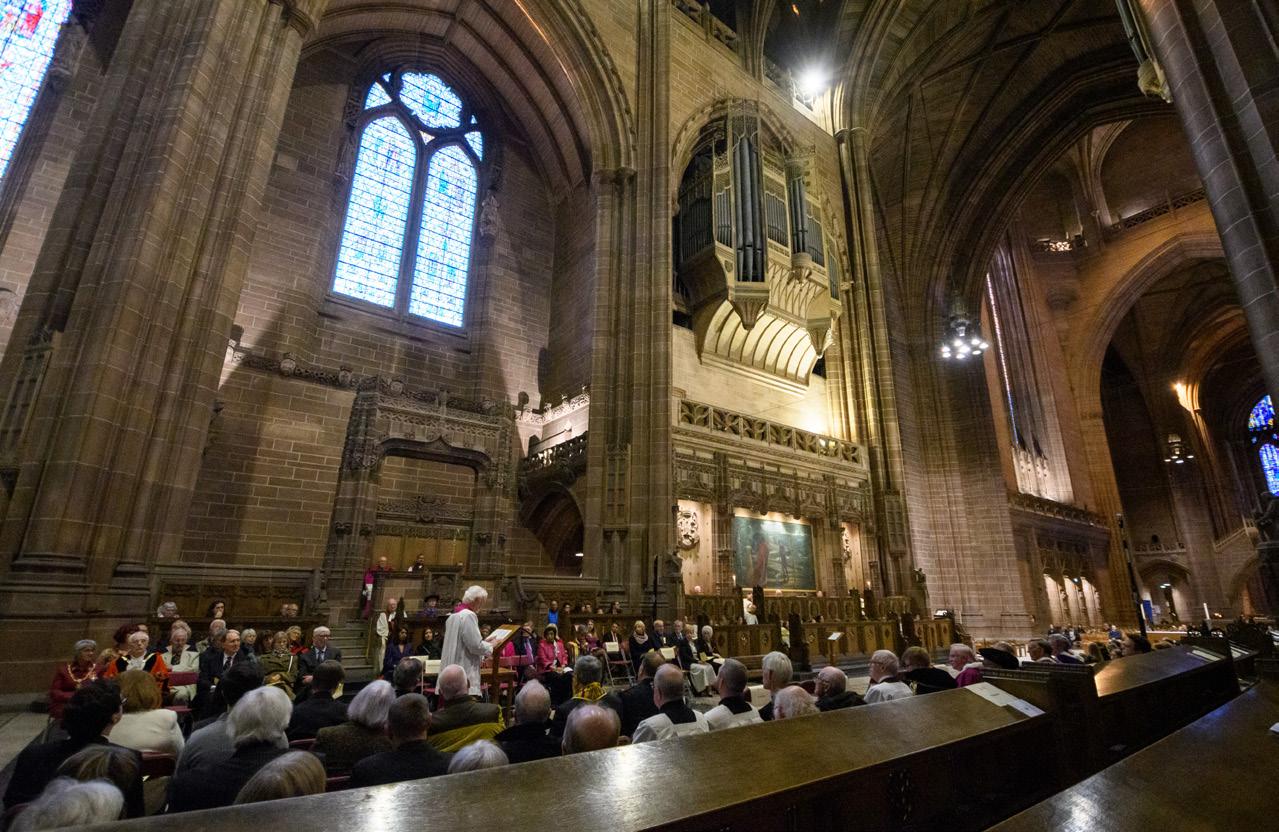
To return to the latter and that strong sense of Christian unity felt in Liverpool, it was not only the city’s bishop and archbishop who were together during the Evensong service. The two cathedrals’ respective deans, Rev Dr Sue Jones and Mgr Tony O’Brien, sat side by side too.
“We all have our different church dogmatics and history and ways of understanding faith, but at the end of the day there is one God, and the fact that in Liverpool we can come together to celebrate the achievements of Gerald Pillay is a wonderful way of working, especially in such a divided world,” said Rev Sue.
It is a hope-filled thought – and Gerald himself offered something similar as he looked back on an evening to remember.
“I can’t imagine any other city in Europe where the Papal Nuncio goes to the Anglican Cathedral,” he said. “In Liverpool, nobody sees it as odd. Here it’s natural to walk across Hope Street together and this event was another celebration of that unity that we’ve achieved in Liverpool.”
Read the ‘Dialogue & Unity’ column on P30 for more on Professor Pillay’s investiture




My first parish priest after Ordination was Father E.K. Taylor at Holy Family Parish in Southport. He had a particular fondness for the memorial of Saint Martin of Tours which we keep, by date, on 11 November.
We read in the Office of Readings for St Martin that even in his advanced years – and he was over 80 years old when he died – he undertook an arduous journey to part of his diocese to bring resolution to a dispute which had arisen, and in this way to cement unity among the people there.
Martin was a man of deep-rooted charity, who is often depicted as a soldier on horseback cutting his cloak in half in order to share it with a poor man. That charity extended not only to giving of himself and his own possessions for the good of others, but to actively working to bring peace, understanding and reconciliation where there was unrest and uncertainty. This too is charity and love of others – to bring peace into their lives. He is also
On 10 October, a group from the Isle of Man travelled to York Minster for the consecration of the Venerable Patricia Hillas as the new Anglican Bishop of Sodor and Man.
The ceremony took place on the feast of Saint Paulinus, the first Archbishop of York, and was led by Archbishop Stephen Cottrell, his 98th successor. Bishop Tricia is to be installed as bishop in the Cathedral Church of St German in Peel on 16 November.
Two other bishops were consecrated in the same ceremony: the new bishops of Selby and of Whitby. In the sermon, Canon Paula Gooder spoke of how Paulinus was sent by Pope St Gregory the Great along with Saints Justus and Mellitus to convert England. I felt part of a chain of faith with those who have gathered in this same spot since 627 AD. My previous visits to the Minster had been accompanied by dark skies and rain. This time the sun shone, the building looked its best and when we sang, we raised the roof.
The Gospel reading was Matthew’s account of the Ascension. He relates how, when the disciples saw Jesus, they: “worshipped him; but some doubted”. The preacher wondered how many doubted and how many worshipped, but went on to suggest that maybe they both doubted and worshipped at the same time. Doubt is a part of faith and it doesn’t stop
Canon Philip Gillespie
sometimes known by the name Martin the Merciful, which is a title any of us should be proud to carry!

On 10 November this year, we will also keep the anniversary of the cessation of hostilities at the end of the First World War – a conflict which sadly did not live up to its name as the “War to end all wars”. To turn our minds to peace, to an end to that mistrust and fear which can so easily not only justify but also condone violence and hatred between communities, peoples and nations, this too is active charity and rightly deserves the beatitude: “Blessed are the Peacemakers”.
At our celebration of Mass each day we say: “Deliver us, Lord, we pray, from every evil, graciously grant peace in our days, that, by the help of your mercy, we may be always free from sin and safe from all distress.”
Amen to that.
Mgr John Devine OBE
us from worshipping.
And worship, in turn, strengthens our faith.
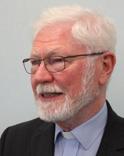
Born in Malaysia, Bishop Tricia grew up in London and has served in various roles since ordination as an Anglican priest. In 2010, she became Archdeacon and Canon of Westminster and Chaplain to the Speaker of the House of Commons.
Sodor and Man is the smallest diocese in the Church of England, with 45 churches and 27 parishes.
Life on the Isle of Man could not be more of a contrast, but she has family connections on the island and has been a regular visitor over the years.
Bishop Tricia also brings with her experience of an earlier career as a social worker accompanying people with HIV and adults with disabilities. We look forward to welcoming her.

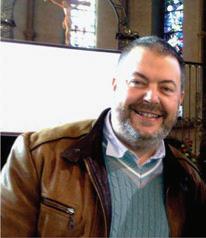
Many years ago, two women felt by the Spirit to open a drop-in for homeless people. It was open, to anyone regardless of any differential to put on them.
Compassionate service was right at the heart of Eileen and Mary’s lives. They were both, without doubt, women of faith for whom Jesus was at the centre of everything they did. Their lives of compassionate service were rooted in that faith in the Lord.
They ran the day centre for several years until Eileen went to live in the north-east. Mary died at a relatively young age, but I like to think that there were many to welcome her to the banquet because of her compassion and mercy.
Discipleship is not some personal privilege to be jealously guarded. Yes, it’s a gift but it’s a gift to be shared and there are some people who have the gift of discipleship but are just unable to recognise it. Karl Rahner used to talk of anonymous Christians. Both Mary and Eileen recognised that we have no monopoly on Jesus and within whom He works. The centre was staffed by people of good will, some of whom would say they had no faith. Our challenge as people of faith is to appreciate the good deeds done by others and name them as ‘building the kingdom’.
That’s a real moment of conversion. It demands that we move beyond petty small mindedness and enter into the spacious mystery of God who works in and through whoever He chooses – the good Muslim, Jew or Hindu, as well as Christians and all people of good will.
The invitation to believe in a God who is always more is so relevant for us today. We have to recognise that God is bigger and more than we can ever imagine so that we can understand how and in whom He works.
It begs the question about what we do with what we call the outsider, those we dismiss as outside God’s plan. They too are wonderful creations of God. The barrier between those who know they are the chosen people and those who do not yet know has been broken down by the Cross, which tells us how important we are.
We are all equal in God’s sight. We are all loved by God. To perpetuate anything else is to create a lie that sadly many people believe in. We perpetuate that lie by carrying on the scourge of disunity within our own tradition and between Christian traditions.
We carry on with the barriers between the Muslims and the Hindus and the Sikhs. We expel the sinner, the divorced and re-married, the gay people.
Desmond Tutu once said: ‘When we see others as the enemy, we risk becoming what we hate. When we oppress others, we end up oppressing ourselves. All of our humanity is dependent upon recognising the humanity in others.’
Therefore, we too have to bring ourselves to God for healing so that we can open our hearts to those we call the outsider and rejoice in the work of God, wherever we see it.
Father Chris Thomas
by Neil Sayer, Archdiocesan Archivist

The Diocese of Lancaster was established a century ago this month, partly from areas of Lancashire that had been overseen by Bishops and Archbishops of Liverpool for decades. There was little fanfare over the new administrative area, and in some ways, it was an odd decision. Nobody locally had been agitating for it, and it took Archbishop Keating rather by surprise. The boundaries of English and Welsh dioceses date back to the restoration of the Catholic Hierarchy by Pope Pius IX in 1850. They weren’t carved in stone: Portsmouth, Leeds and Middlesbrough were all newly created before the end of the century. Just before the First World War, Pope Pius X had been considering the potential benefits of creating additional dioceses, and even at the height of the war, in 1917, the Diocese of Brentwood was carved out of the Archdiocese of Westminster. But discussions about a potential division of Liverpool seemed to have been shelved by 1922. In that year, Archbishop Keating, recently appointed to Liverpool, reported to the Holy See on the state of his new fiefdom and sought a postponement of any decision on a proposal to divide it to create a new diocese. Strangely enough, the sheer size of his new archdiocese doesn’t seem to have suggested that its reduction might have been a handy reduction in his workload. Of course, he hadn’t yet had to go out on visitation to Barrow, or Coniston, or other of the furthest-flung parts of his territory. He did acknowledge that his predecessor could only manage a sevenyear visitation cycle, although that certainly didn’t mean that any part of the archdiocese felt overlooked. His arguments against division were largely based on the expansion of the seminary at Upholland, and the launching of the Archbishop Whiteside Memorial Fund, intended to build a Cathedral, towards which the parishes in the north of the archdiocese were significant and enthusiastic contributors. He thought he had obtained “a formal assurance from the Consistorial Congregation that partition should be postponed until the scheme had had time to mature.”
He was a little taken aback when, by a Papal Bull dated 22 November 1924, a new Diocese of Lancaster was formed of that part of the county of Lancashire north of the River Ribble, taken from the Archdiocese of Liverpool, and the counties of Cumberland and Westmorland, taken from the Diocese of Hexham and Newcastle.


Archbishop Keating protested to the Pope in fairly strong terms about the way, he felt, his advice had been ignored, but the deed was done. 46 parishes and 91 priests left Liverpool to join Lancaster. 67,647 Catholics were dropped from the diocesan statistics: Liverpool’s Catholic population was still far greater than that of any other diocese, and we still ranked second in the number of churches and chapels, but Westminster now had the greatest number of secular priests in its parishes.
“The partition of the archdiocese has come as a shock to all of us”, Archbishop Keating said in a Pastoral Letter to clergy and parishioners. “It had long been regarded by many as inevitable, sooner or later”, and while he made no reference to his own deeplyfelt sense of disappointment, he urged acceptance of the situation. “We shall give ungrudging support to our brethren and their new Bishop in their efforts to build up a strong and flourishing diocese in North Lancashire.” Indeed, a financial settlement was quickly agreed upon with the new diocese, and arrangements were made for the continuing shared use of the facilities for training clergy both at Upholland and Ushaw.
The town of Lancaster was nominated as the seat of the new Bishop, and St Peter’s Church was raised to the status of a Cathedral. Among the clergy who transferred from the Diocese of Hexham and Newcastle, half were Benedictine monks, and it may have been their numbers that meant that Lancaster’s first Bishop was also a member of the Benedictine order. Bishop Thomas Wulstan Pearson had enjoyed the happiest years of his priestly life giving pastoral care at St Mary’s in Liverpool city centre between 1912 and 1916. Here, he established a reputation for hard work and a kindly disposition. He was consecrated at Lancaster by Archbishop Keating on 24 February 1925.
“No estrangement is likely to take place between the archdiocese and its offspring”, said Archbishop Keating. “On the contrary, it will be our aim, in conjunction with the Bishop of Lancaster, to encourage the most cordial relations and closest possible co-operation between the two dioceses.” A century of harmonious working with our neighbour shows how successfully the division has been managed.

If you’ve got any news from your parish that you’d like featured e-mail us with the details at: CatholicPic@rcaol.org.uk
The 170th anniversary of the opening of Our Lady of Reconciliation De La Salette on Eldon Street, Liverpool, was marked with a special Mass presided over by Archbishop Malcolm McMahon OP on Saturday 7 September.
The historic church, a cornerstone of the local Catholic community in Vauxhall, has been a place of worship and reconciliation since its foundation in 1854.
The La Salette congregation was established following the 1846 apparition of the Virgin Mary to two children in La Salette, France. She called for reconciliation and penance, themes that continue to inspire the parish’s mission today.
In his homily, Archbishop McMahon reflected on the rich history and enduring legacy of the church. He praised the parish for its unwavering commitment to serving the local community over the decades. “The heart of this parish is the people who have faithfully kept its mission alive,” the Archbishop said. “Your dedication and spirit of service reflect the message of Our Lady of La Salette, a call to healing and unity.”
The Archbishop also offered words of gratitude to the clergy, volunteers, and parishioners for their tireless efforts in maintaining the church’s spiritual and social outreach, especially during challenging times.
The congregation expressed its appreciation for the Archbishop’s message and the parish’s continued role in the community. The celebration was followed by a gathering that honoured both the church’s legacy and future.
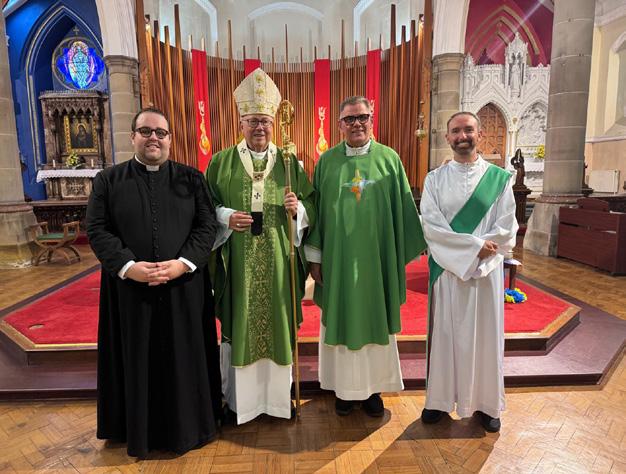
People from across the archdiocese came together at the Metropolitan Cathedral on Monday 7 October to pray for peace in the Holy Land.
A year since the beginning of the terrible conflict in the Middle East, the early-evening Mass at the Cathedral’s Blessed Sacrament Chapel was dedicated to prayer for peace for all people in the region, whatever their religion.
Archbishop Malcolm was the chief celebrant of this Mass for the Feast of Our Lady of the Holy Rosary, and he led the congregation in saying the Rosary beforehand.
This feast was instituted by Pope St Pius V in recognition of Our Lady’s intercession for victory over the Ottoman fleet at the 16thcentury Battle of Lepanto, explained the archbishop, who added: “Our prayer should not be for victory with its accompanying destruction, injury and death. Notions of the triumph of good over evil should give way to prayers for peace when all peoples live in harmony enriched by the gifts we bring to each other.”
Present at the Mass were members of the Knights of the Holy Sepulchre, whose mission is to support the Christian communities of the Holy Land.
In celebrating the Mass, Archbishop Malcolm was evoking the spirit of St Paul – who demands that ‘bishops have a concern for all the churches’ – and responding, moreover, to Pope Francis’
call for 7 October to be a day of fasting and prayer for peace in the Holy Land.
“Let us unite with the power of Good against the diabolical plots of war,” said the Pontiff himself, who called for the “immediate release” of the hostages held by Hamas in Gaza and a restored flow of “humanitarian aid” into the ravaged enclave. Pope Francis also demanded an “immediate ceasefire” on all the fronts on which Israel is fighting, including Lebanon.
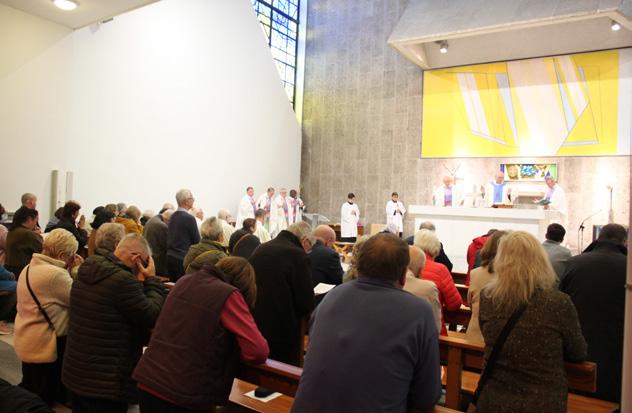
On Saturday 21 September (World Alzheimer’s Day) St Mary’s, Woolton, in their ongoing efforts to become a Dementia Friendly Parish, hosted a wonderful evening of entertainment with all proceeds going to the Alzheimer’s Society.
The many gifts donated by local supermarkets, restaurants and beauty salons were auctioned on the night, and together with raffle prizes and a dedicated JustGiving page, a whopping £3,000 was raised for the Alzheimer’s Society!
A great time was had by more than 80 parishioners and friends who came together for an evening of song and dance to support this worthy cause. The evening’s entertainment was led by MC Phil Ford, with music and song from the wonderful pianist/vocalist Victoria Sharpe, a resident artist at the Puffin Rooms in Liverpool. Victoria regularly accompanies her mum to the weekly dementiafriendly activities that take place in St Mary’s parish hall. Guests were also entertained by the soulful tones of singer Stevie S. Stevie is currently living with early-onset dementia, but still loves to sing and entertain his audiences.
The delicious food on the night was lovingly prepared by parishioners Mary and Phil Monkhouse and friends. Mary has trained as a Dementia Friends Ambassador and continues to deliver Dementia Awareness sessions to local schools and businesses around the city.
For more information about becoming a Dementia Friendly Parish and the activities available at St Mary’s parish hall, please contact Ann O’Neill at: stmaryswoolton@rcaol.org.uk
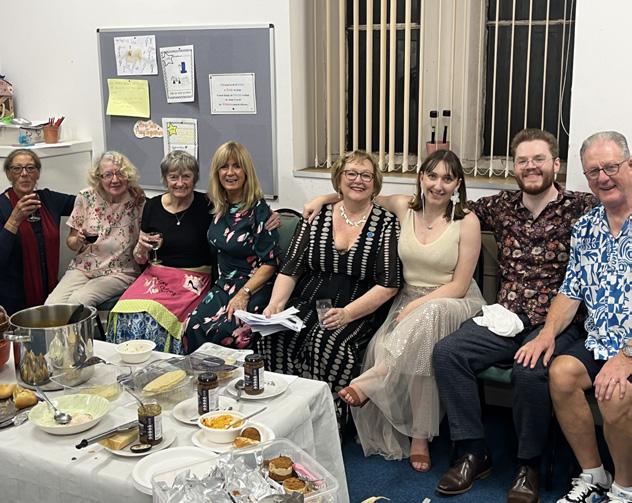
You can also find out more on the parish website at: www.stmaryswoolton.org.uk
If you wish to donate to the JustGiving page, you can do so by scanning this QR code.

It was an evening of celebration in Warrington, as Fr Raymond Anyanwu CSSp celebrated his silver jubilee of priesthood.
Since 1999, Fr Raymond has been a priest in several different countries. He was ordained in Nigeria and has also been a priest in Senegal and South Africa, before making his home in Warrington over the last six years.
He celebrated 25 years of priesthood with a special Mass held at St Joseph’s, with a full Church. People from across the parish attended, while priests from the local deanery and other priests from the CSSp order were all concelebrating.
Just like on Pentecost Sunday, Fr Raymond had the Indian Community Band lead the procession in before Mass got underway. Fr Brendan Aroh, formerly of St Mary and St John parish in Newtonle-Willows, and of the same order, gave the homily. The pair were in school and trained for the priesthood together. He brought up memories of them playing football, and had plenty of funny stories about Fr Raymond, as well as praise for his character, and for what he has brought to the priesthood.
Children from St Joseph’s, St Vincent’s and St Gregory’s Catholic Primary Schools also said the Prayers of the Faithful.
After Mass had ended, Fr Raymond was presented with not one, but two Papal Blessings. One was from the Deanery (Warrington and Widnes) and the other from the parish.
Also, as the next day was his birthday, he was also presented with a bottle of whiskey by Canon Dave Heywood, Area Dean on behalf of the other priests in the deanery.
After posing outside for photographs, everyone then went on to the Parish Centre, where there was food, cake, and live music.
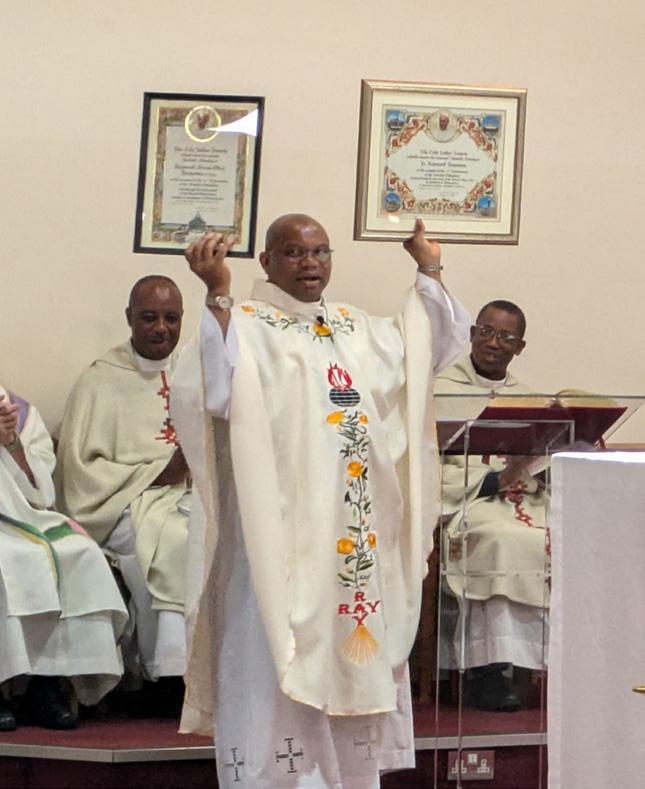
In an effort to combat food poverty, two churches in St. Helens, St. Austin’s and St. Teresa of Avila, have joined forces to establish a community foodbank, supported by the local St. Vincent de Paul (SVP) charity.
Working with parish priest Father Martin Kershaw, this initiative aims to address the growing need for food assistance in the area, and across the UK. Shockingly, recent surveys have shown that there are now more foodbanks in the UK than McDonald’s restaurants.
The “Feed My Lambs, Feed My Sheep” initiative, launched several months ago has garnered significant community support. Local parishioners from both churches have been contributing by donating food parcels and essential supplies.
Thanks to the collaboration with the SVP, the project has flourished. A team of enthusiastic young volunteers play a crucial role in managing the donations, helping to collect items and sorting through them to ensure that nothing goes to waste. Volunteers not only assist with donations but also deliver food parcels directly to families in need.
The project exemplifies the essential role that local churches and volunteers can play in addressing food insecurity and fostering a sense of community solidarity.
As the food arrives at the food bank, the dedicated volunteers spring into action, sorting through the large variety of canned goods and other items. They will check the expiry dates on each tin. Those products with a shorter shelf life will be prioritised for distribution to prevent any unnecessary waste, which is critical in maximising the impact of the donations. This approach not only helps ensure that the food bank can provide fresh and safe options for those facing food insecurity, but it also reflects a commitment to sustainability by minimising waste. By efficiently organising the food donations in this way, the volunteers play an essential role in fostering a supportive community and alleviating hunger effectively.
As the “Feed My Lambs, Feed My Sheep” project continues to grow, the need for more volunteers and donations remains critical. Anyone interested in supporting the foodbank, whether through volunteering their time or contributing food items, is encouraged to get involved. Additionally, those affiliated with other organisations looking to collaborate with the SVP are also welcome to join forces in this essential effort. Together, we can make a significant difference to families facing food insecurity in our community. For more information on how to help, please contact St. Austin’s or St. Teresa of Avila churches directly, or your local SVP society.



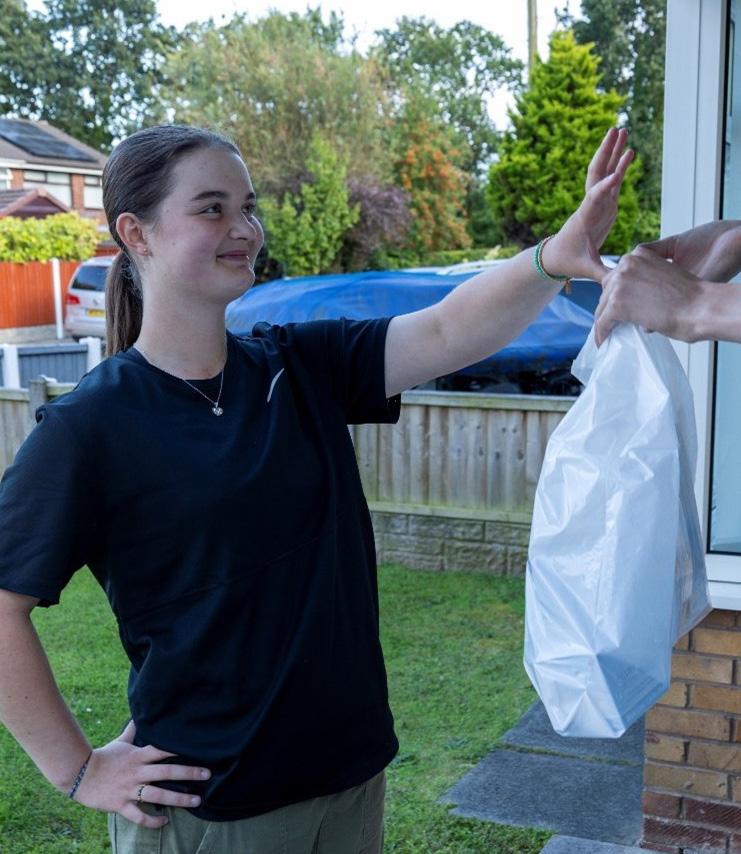
St. Aidan’s, Winstanley, celebrated the 50th anniversary of the church’s opening on Sunday 6 October, with Mass in the church and celebrations in the adjoining parish club.
The church was opened officially on 1 October 1974 by Archbishop Beck together with Bishop Gray, Bishop Harris, Canon Walsh, Canon Glass, Father Cronin and Father Cadogan. Father Daniel Cadogan realised that Winstanley and Highfield were growing rapidly, with new houses being built and young couples moving in, and that a new parish was needed. The future parishioners of St Aidan’s worked hard to raise the money for the new school and church. Masses were celebrated in private homes before the first Mass at the Parish of St Aidan, Winstanley, was celebrated by Fr Cadogan in the newly built St. Aidan’s school on 5 December 1971. There were two baptisms at this first Mass.
Contributions of £2 per person were received to help buy chairs for the hall and a carpet to protect the floor. Every Saturday evening, parishioners would roll out the carpet and set up the school hall for Mass the following day. This went on until the church was finished in 1974. The architect Anthony Grimshaw had designed the plans for the new church and social centre and builder Robinson completed the construction.
In Sunday’s anniversary celebration, Mass was celebrated by Canon Pat MacNally, with Deacon Jim Cardy assisting, and with hymns led by the church’s music group and bidding prayers read by the young people. Canon MacNally thanked the parishioners for what they had done and continue to do for the parish. After the Mass, all retired to a full social centre to continue the joyous

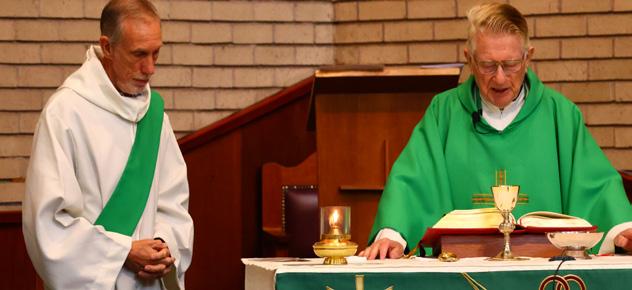
celebrations with refreshments, dance and song. The children particularly enjoyed the dancing and singing. The parish has a strong, vibrant catholic community, including several groups such as the UCM, Little Church and Youth Effect. Parishioner Andy Connellan commented, “the parish has so much to be thankful for.”
On Sunday 1 September, the community of St. Aloysius Parish gathered to commemorate a series of remarkable milestones. The celebration marked the 90th anniversary of the parish’s founding, alongside a triple milestone for their beloved parish priest, Fr. Ealey.
Fr. Ealey’s Ruby (40th) Ordination Anniversary was honoured, as well as his 30th year serving as parish priest at St. Aloysius. Adding to the festivities, the congregation also celebrated his 71st birthday, making it a day filled with joy and gratitude.
Parishioners came together for an afternoon of fellowship, sharing stories and memories that highlighted the rich history of their community. The organisers would like to express their heartfelt thanks to everyone who contributed to the event, whether through planning, participation, or simply attending, making this a truly special day in the parish’s history.
CONGRATULATIONS NIAMH BARRY and MICHAEL MGBAFULU, Who were both enrolled into the guild of St. Stephen by Fr. Ealey at Mass at St. Aloysius, Roby on Sunday 11 August.
We pray that Niamh and Michael’s ministry as altar servers will be a long and fruitful one.

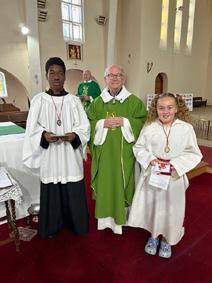








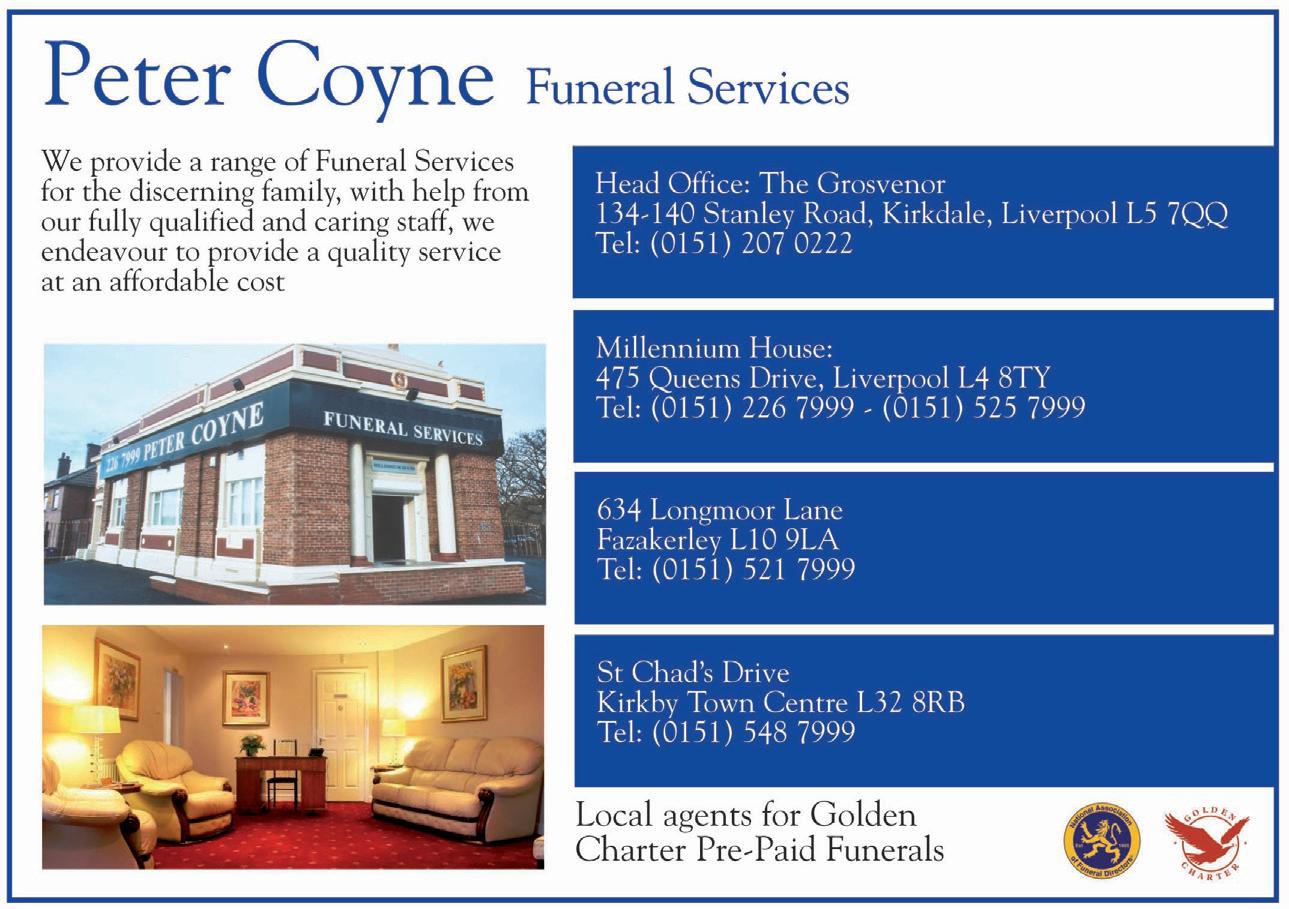
Thursday 31 October – 12 November
50 Faces of the Holy Land Exhibition
Our Lady of the Assumption Church, Gateacre, is hosting a photographic and audio exhibition of the lives of people in Israel, Gaza and the Occupied Territories. Stories are told by people of all ages, and experiences; we learn what it is to live in a land that is known by so many to be holy. The faces are marked with its history, its diversity, its joy and its suffering. At this time of increased fear and violence in the region become more aware of the lives of real people. Come and light a candle for peace. Open 8.30am-1.30pm each day. All welcome. theholyland.org.uk/home/50faces

Thursday 7, 14, 21 November
Scripture Mornings: Reflections on the Letters of John
Starting at the end of October, and running through November, the Irenaeus Project will be hosting a series of Scripture Mornings reflecting on the Letters of John. All are welcome to attend. If you cannot attend in person, email jenny@irenaeus.co.uk who can provide you with a Zoom link, so you can join online.
Tuesday 5, 12, 19 November
CDSC Life in the Spirit Seminars
The CDSC (Charismatic Service of Communion) are facilitating the ‘Life in the Spirit Seminars’. This is an opportunity to recognise the work of the Holy Spirit in our lives. However, if your prayer group would like to participate as a group in your own venue it is possible for you to request a link and join as a group on Zoom. For any further information, and if you require a link, email jenny@irenaeus.co.uk
Wednesday 6 November
Ecumenical Service for Peace in the Holy Land
Archbishop McMahon will lead a time of prayer for peace at this time of increased of violence, hatred, fear and mistrust in the Holy Land at Our Lady of the Assumption Church, Gateacre. Canon Mark Madden will preach. Through the Word of God, stillness, reflection, and song, we are invited to be united in our cry for peace. All are welcome! The service starts at 7pm. Introduction to the Gospel of Luke
The first of four talks in the Parish of St Wilfrid, Widnes on the Gospel of Luke. This introduction will be hosted by Fr Andrew Robinson. All are welcome to attend. Each session begins at 7pm in the St John Fisher church hall, before benediction in the Church at 8pm.
Tuesday 12 November
Time Out on Tuesdays
Wanting time for yourself? Time to stop and reflect? Time to step aside for a while from the daily round of life? Then why not join The Sisters of Our Lady and the Cenacle on a Tuesday to get away for a few hours to stop and ponder the important things of life? No need to book, just come along and maybe bring a friend. Suggested offering for the day is £10, bring your own lunch, tea/coffee provided. For further information contact Sr Winnie 0151 722 2271.

Wednesday 13 November
Luke, the Gospel of the Outsider
The second talk on the Gospel of Luke in St Wilfrid’s parish, Widnes. This one will be led by Sr Anne Buckeridge. The talk begins at 7pm in St John Fisher church hall, before benediction in the Church at 8pm. All are welcome to attend.
Wednesday 20 November
Luke, the Gospel of Prayer
The third of four talks in the parish of St Wilfrid, Widnes on The Gospel of Luke. This one will be led by Sr Louise Swanston. The session will begin at 7pm, in St John Fisher church hall. before benediction in the Church at 8pm. All are welcome to attend.
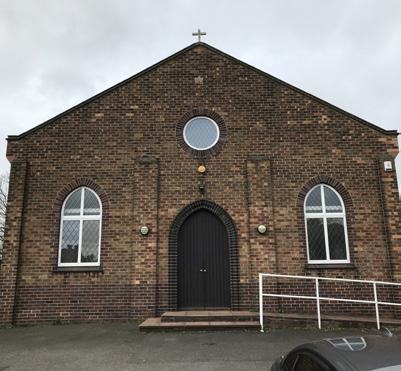
Wednesday 27 November
Luke, the Christmas Gospel
The final talk on the Gospel of Luke at the parish of St Wilfrid, Widnes. This one will be led by Fr Derek Lloyd. The session will start at 7pm, at St John Fisher church hall, followed by benediction at the church. All are welcome to attend.
Thursday 28 November
Social Action Network Event: How to influence decision makers: From national politicians to Church representatives
This Social Action Network will focus on how we can make systemic change - both nationally and locally - by shining a light on the skills and planning needed to influence decision makers. It also includes inspirational stories of when simple actions have had great effect. You can sign up via the archdiocese website, on the events section.
Saturday 30 November
Haydock Male Voice Choir Concert
Join us for an evening with the Haydock Male Voice Choir at Our Lady and All Saints Church, Parbold, on Saturday 30 November at 7:30PM. Tickets are £10 and can be purchased by emailing parbold@hotmail.com or calling (01257) 463248. The church is located on Lancaster Lane, Parbold, WN8 7HS, with car parking available on-site.

by Dr Christopher McElroy Director of Music, Liverpool Metropolitan Cathedral
In addition to my role as Director of Music at the Metropolitan Cathedral, I am also the Director of the Archdiocese of Liverpool Schools Singing Programme.
I am acutely aware that singing is for ALL children, not just those who can devote the time and commitment to be a cathedral chorister.
In order to extend singing opportunities, the AOL Schools Singing Programme was launched in 2022. Staff from the music department visit schools to lead children in singing and work with them to prepare music for performances and liturgies.
As it currently stands, we partner with 22 schools in the archdiocese, enabling over 2,000 children each week to sing under the guidance of one of our even Choral Directors. We currently have a waiting list of schools, and very much hope to expand our partnerships further in the coming months and years.
Our Choral Directors visit partner schools on a weekly basis, delivering high-quality singing sessions covering a mixture of sacred and secular repertoire. Our bespoke scheme of work incorporates the National Curriculum for Music and the archdiocese RE curriculum, meaning that singing sessions overlap with multiple areas of school life.
For me personally, singing is a primary form of evangelisation - whether we are singing the stories of our faith or non-religious music, we are each using our God-given talent and

enriching the life of our schools and parishes. Singing together in a group is about so much more than music. It helps children develop so many life skills such as creativity, problemsolving, performing, exploring and perseverance.
The positive impact of our programme, as evidenced in feedback from headteachers, drives our team to make singing a key part of every child’s experience!
We have been thrilled to see our hymns really take off again and your considerable energy and enthusiasm in each weekly session has had such a positive impact on the children and staff. The learning opportunities you have provided have been of the highest quality as well as being thoroughly enjoyed by all. Please keep up the excellent work!
By Pat Murphy
October for me is a month of happy and sad memories. It’s the month in which so many of my close family and friends have gone to the Lord. As I write this column, it is the feast of Our Lady of the Rosary - and the anniversary of the death of my maternal grandmother. She died on a very appropriate day, as she rarely had a rosary out of her hands.
Saying the rosary is very much part of a Lourdes Pilgrimage. The rosary is said at the Lourdes Grotto daily at 3pm. I have to admit that I struggle with five decades of the rosary one after the other. My prayers and meditation become dry. My thoughts drift into what I am about to do next and stray down many roads. I enjoy going to the grotto on my own, talking to Our Lady and saying just one decade of the rosary. I find it much more meaningful. Maybe because my concentration can last that long! I am sure she doesn’t mind. I try to do this a couple of times a day when in Lourdes.
The feast of the Rosary this year also has marked the anniversary of the latest conflict in the Holy Land, and we have been asked for prayers especially on this day for peace. Also, the last line of the psalm at Mass this weekend was “pray for peace in Israel;” The psalm was written hundreds of years ago but is still so appropriate for this war-worn land. That one line stayed with me through my Sunday Mass and the day.
Our blessed Lady has many titles – she is Queen of Heaven and Earth, so the whole world needs to ask for her intersession peace in the Holy Land, Ukraine and so many other parts of the world.
On a lighter note, bookings have opened today for the youth pilgrimage next year. Soon, all of us will be able to start planning for our 2025 Pilgrimage - a special year. Pope Francis has designated the 2025 Jubilee year theme for us as “Pilgrims of Hope”.
Pilgrims for hope and peace in the world. Our Lady of Lourdes, pray for us.
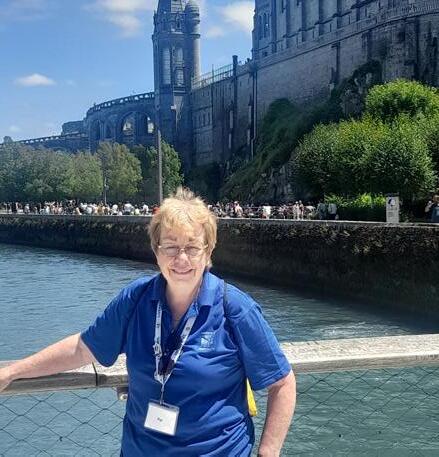

by Paul Pimblett
In this article, I would like to revisit the same topic I focused on this time last year - the Martyrs of England and Wales. By the time this article is published, we will have celebrated the feast day of the Martyrs on the 25 October, and so I thought it fitting to call to mind their witness in the face of persecution.
In 1970, the Forty Martyrs of England and Wales were canonised. There were, however, hundreds of men and women, lay and clerics, who were executed between 1535 and 1679 for bearing witness to the Catholic faith. I currently study only three miles from Tyburn where 105 of them, mostly priests, met their glorious end. Many of the martyrs were hanged, drawn and quartered for treason. They willingly went to their deaths as witnesses to Christ and the authority of His Church. From the priests who were smuggled back into England to minister to the faithful, to the laity who sheltered and cared for them, their sacrifice served to preserve Catholicism in England. We have a particularly strong connection to them through Saint John Arnold, who was born in what would become our archdiocese.
I have a personal connection to those men who, having fled England under the dark days of persecution, studied at the Royal English College in Valladolid, Spain, as I studied there myself. I was also entrusted to the care of one martyr, Blessed Ralph Corby, when I began my studies. I continue to seek his intercession now in Allen Hall, three miles from his place of execution.
On the 25 October, two men in our seminary will be admitted as candidates for holy orders. It is fitting that this will happen during the celebration of those who gave their lives for the priesthood. It is also a striking time for us as seminarians, and one which causes us to reflect on the sacrificial nature of our own vocation. We may not, thank God, meet the same gruesome end as the martyrs, yet our future ministry will have its own challenges and trials. We must therefore turn to the martyrs continually for strength and comfort. We must never take for granted the freedom we have to practise our faith today nor forget the lives and deaths of those who were true to Him till death.
Martyrs of England and Wales, Pray for us.

Pablo Guidi Catholic Social Action Coordinator

On Sunday 3 November, we celebrate the feast of St.
de Porres, the illegitimate
of
enslaved young black woman. Archbishop Malcolm reflected on St. Martin’s influence in his recent message on racial justice – an extract of which is reprinted here:
“Dear Brothers and Sisters,
In our Metropolitan Cathedral, there is a statue of St. Martin de Porres. He is one of many saints of colour and is known for his saying “Always consider others as more holy and more worthy than you”. He provides an insight into how we should live out our lives of faith, but also an example of diversity in the Catholic Church.
The diversity I see in our cities and our parishes brings such a richness. But it also brings challenges... Racism can be one of these, and it saddens me to know that people continue to experience racism as part of their day-to-day lives, and that it even exists within the Church.
…Racism starts when someone thinks their own race is superior… the result is that they judge people from other races or ethnicities as inferior and unworthy of equal regard. This can lead people to exclude, ridicule, mistreat, or unjustly discriminate against persons on the basis of their race or ethnicity.
Racist acts violate justice and are therefore sinful. They reveal a failure to acknowledge the human dignity of the other. A failure to recognise the other person as the neighbour Christ calls us to love (Mt 22:39).
…I encourage you in your parishes to continue the synodal journey, to understand the experiences of all the baptised. Have conversations about racism and its impact. I invite the clergy and the laity in our archdiocese to begin to do something practical to celebrate the diversity in our parishes. To also think about the images and statues we use and how they can better represent our communities.
So, we ask of them [St. Martin de Porres and St. Peter Claver] and the Blessed Mother Mary, help us in this task. May their intercession guide us in the wisdom and mercy of the Lord Jesus.”
You can watch a video of this message on the Archdiocese of Liverpool YouTube channel.
If you would like support in your parish, please contact Pablo (Archdiocesan Catholic Social Action Coordinator) 0151 522 1042 or p.guidi@rcaol.org.uk
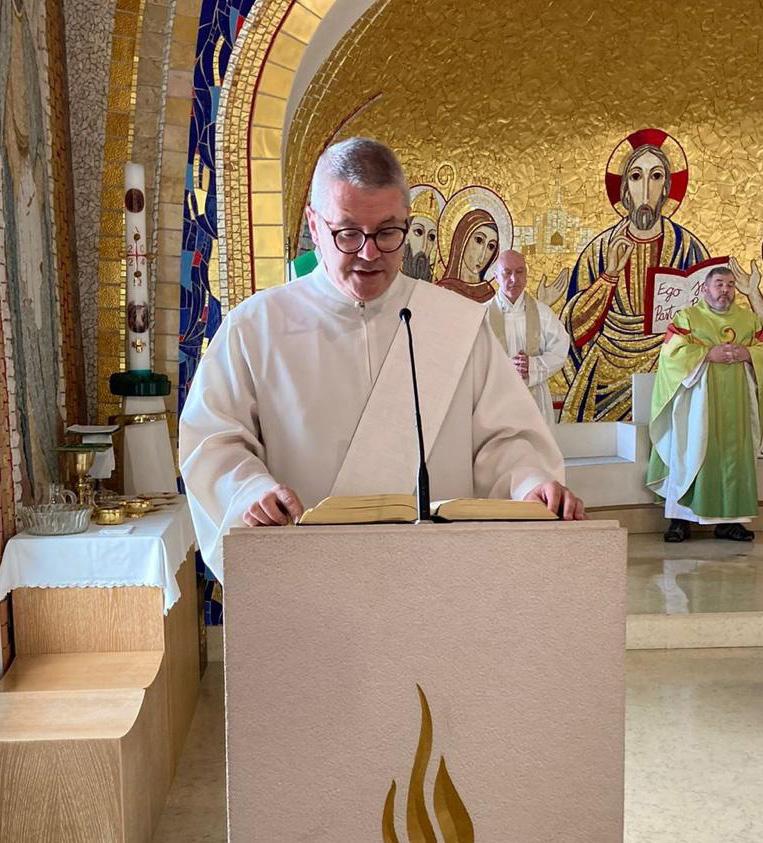
The Archdiocese of Liverpool has almost 70 serving deacons and it would be reasonable to suggest that none travels as far and wide in his ministry as John Power.
As a deacon serving with the Royal Army Chaplain Department, the 53-year-old has had deployments to Germany, Kosovo and Poland during the past four years.
Yet it was not adventure that drew John, who grew up in St Alexander’s Parish in Bootle, to the role. Prior to his ordination as a deacon at St Oswald’s, Old Swan, in July 2020, he had worked as an IT teacher at Merchant Taylors’ School, Crosby, and “enjoyed supporting students pastorally”.
And there is much need for that in the army where, as a chaplain, he sees many young recruits from challenging backgrounds.
“There are many difficult situations young people have come from,” explains John. “Often, they come out of an unstructured environment into a hyper-structured environment, and that’s where I have a lot of my work. I have conversations with them normally when there are problems, and I see the need for support. But, on the positive side, they learn how to organise themselves and what positive authority is.”
Ordained as a deacon in July 2020, John had been seeking a chaplaincy position when he saw a job advertisement from the Army and the rest, including a 12-week training course at Sandhurst – “I went there and lost three stone!” – is history.
Army chaplaincy, put simply, entails “supporting the military personnel and their families” and he spent his first two years based with the Royal Lancers in Catterick before a second 24-month stint in the same Yorkshire town – this time at the Infantry Training Centre.
“There’s a lot of classroom-based teaching that goes with the role,” says John, who draws on his Merchant Taylors’ experience.
During his time in Catterick, he has also had “the responsibility of ensuring that the Catholic Garrison Church of St Joan of Arc was looked after, and that Sunday Mass and other services were available”.
As for the above-mentioned foreign deployments, they have involved “living cheek and jowl” with soldiers. “Sometimes you’ll be engaged in pastoral conversations about something going on back at home,” he reflects. “Sunday services and field services are also part of the engagement. Field services can range from a whole regiment, with possibly 400 in attendance, or a platoon or section, averaging 20. Most soldiers will tell you they aren’t religious, but
By Simon Hart
they’ll never shy away from a request to take part in the service – be it reading, singing or helping with the logistics of getting a speaker, generator and PA system into the middle of a forest!
“When back in the UK, work can involve intense pastoral conversations and ongoing support,’ adds John. “Supporting quite often young people through their first and very close bereavement is a significant part of these conversations. A great joy, meanwhile, is to be able to baptise soldiers’ babies, conduct their weddings and support them and officiate at funerals of their loved ones.”
It is the pastoral side – that ‘manifestation of Christ the Servant’, as he puts it – that he finds most challenging, but also most fulfilling. “Everyone in the military has clearly defined roles, but in pastoral situations, there’s so much to be done that isn’t defined and this is where the “servant role” of being a deacon is most precious.”
There is one final question: namely whether military chaplaincy and Christian ministry are compatible. John offers the following reply: “I understand this view, but there are two areas that need to be considered. We need an Armed Forces to ensure our and others’ freedoms and lives are protected, and those who choose to serve their country in this way need support just like any other civilian.
“Additionally, many Catholics serve in the Armed Forces and their spiritual care, particularly access to the Sacraments, is vital and life-giving work. As a deacon, a fulfilling part of my ministry in a military context is being able to share the Word of God and bring Holy Communion to those who serve on operations. For them and myself, it’s a visible sign of the Universal Church walking alongside them when they’re far from home and in need of not just pastoral care but spiritual support and food.”

We recall in this ecumenical walk the lives of two great Italian saints of the Counter-Reformation whose devotion to addressing the needs of the Church and its faithful led to important reforms. Despite aristocratic backgrounds, they shared a profound mission of service to the poor.
We start in Aigburth at the Church of St Charles Borromeo, a building ‘of confidence and dignity’ which at 95 feet tall is a significant local landmark. Borromeo was a 16th-century cardinal and archbishop of Milan. His emblem features the motto ‘humility,’ which we took as an appropriate point of departure for our parish pilgrimage.
Head north along Aigburth Road and pass the Grace Family Church on your left where ‘TRUST’ is their message - another appropriate maxim for our walk ahead.
Lark Lane and its lively street culture of cafes and restaurants is on your right. Cross Parkfield Road with its Victorian villas, then walk past the offices of Liverpool Sunflowers - a cancer charity - reminding us of the difficult journeys some people must take.
Continue to the busy junction at Ullet Road and Park Road, then straight to The Elms at the historic boundary of Toxteth Park and Aigburth. Turn right into Peel Street, first left into Miles Street, then continue north. Bear right at the pocket park linking Admiral Street. Many feet have marked an attractive diagonal path across the grass towards the former Methodist Church; we reflected on Proverbs 3:6. Continue up Admiral Street then left into High Park Street.
Here we briefly retrace our steps from last month’s pilgrimage as we approach the church of Our Lady of Mount Carmel. Of all the Catholic churches we visit today on our pilgrimage, this was the sole one whose doors remained open - how might we as Christians work together creatively to assist our clergy and help keep all our churches open? The sanctuary lamp was a powerful reminder of the presence of the Lord, we give thanks to God for this place of peace and a donation to the church for the opportunity to experience it.
Turnn right onto Letitia Street continuing straight on Morton Street then left onto Upper Park Street, right onto Devonport Street. At Northumberland Street go left again, then right onto the busy Park Road for the penultimate stretch.
At Toxteth Tabernacle we reflected on the messages of welcome and hope blazoned outside before continuing north, crossing Upper Warwick Street at the junction. The famous parish of St Patrick’s is now reached, its scale and physical presence a reminder of its significance in Catholic history for the city. Although closed at the time of our visit, its active parish community is evident, witnessing still the line from Deuteronomy 29:9 on its proud edifice: “Keep therefore the words of this Covenant and fulfil them”.
Turn right at St James and up the hill of Upper Parliament Street past the magnificent south elevation of the Anglican Cathedral. Pass Hope Street and after a hundred metres or so turn left into Catharine Street with its lines of handsome early terraces.
At the junction of Huskisson Street, continue past the classical architecture of St Bride’s. Cross the junction at Canning Street. On our left, we now reach another church closely linked with serving the needs of young people whose studies have brought them to the city.
Our destination is St Philip Neri, home to the Catholic Chaplaincy for Universities of Liverpool, John Moores and the Liverpool Institute for Performing Arts. Neri was the founder of the Oratorians; his spirituality is noted for his humility, humour, piety and dedication to the education of young people. We can reflect and celebrate all the parishes we have encountered, who each in their own way continue to serve the many communities who make Liverpool the diverse, devout and fascinating city it remains to this day.
This month’s prayer was chosen by Mary McCloy form the parish of St Agnes and St Aidan.
Take my hand O Blessed Mother hold me firmly lest I fall, I am nervous when I am walking and to thee I humbly call,
Guide me over every crossing, Watch me when I’m on the stairs, Let me know you are beside me, listen to my fervent prayers. Bring me to my destination safely every day.
Help me with each undertaking as the hours pass away.
And when evening falls upon us and I fear to be alone,
Take my hand O Blessed Mother once again and lead me home.
The Assumption by Adam Kossowski, The Rosary Way, Faversham, Kent
Send us your favourite prayer, along with your name and your parish, at CatholicPic@rcaol.org.uk to be featured in next month’s issue!
Blessed James Bell
Born in Warrington, Blessed James Bell was educated at Oxford University. He was then ordained a priest under Queen Mary I’s reign. After the reformation, he continued as an Anglican Minister for 20 years, after which he sought reconciliation with the Catholic Church and continued priestly duties. He promoted the Sacrament of Penance, calling the faithful to receive the Lord’s forgiveness. His life is commemorated on 20 April.
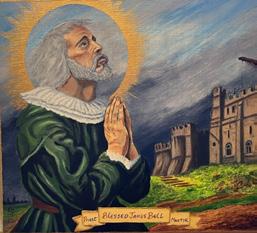




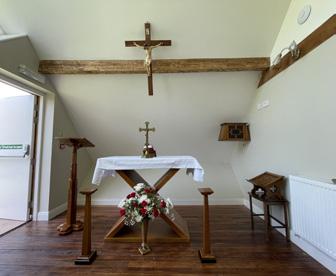



Staff and pupils at Maricourt Catholic High School enjoyed a fruitful day of celebrations to mark Mercy Day.
The day remembers the founding of the first Mercy House in Dublin by Catherine McAuley, the foundress of the Sisters of Mercy.
Pupils were reminded in prayer and liturgies of the pioneering work Catherine established in Ireland and how this grew from one house in Dublin to a worldwide organisation of promoting the Mercy values of service, hospitality, courage, justice, respect and compassion.
The pupils then thought about how they could continue this mission of mercy at school, in the local deanery and in the global community.
In form time, pupils were asked to think of who needs the most mercy in the world. A Year 11 student, Millie, wrote: “Lord, we call upon you to bring mercy and light to the hurting and broken and to bring comfort to those whose hearts are worn out.”
Year 7s had a special Welcome Mass at St George’s Catholic Church in Maghull with their parents, carers and parishioners.
Father Chris Fallon spoke of Mary’s’ ‘yes’ to God and how we can also say yes to God by living out our Catholic faith.
Afterwards, students across the school enjoyed cookies and staff enjoyed cakes, on what was a real day of hospitality. Parents made donations and Maricourt was able to give this to food bank charities within its local area.
Chaplain of Maricourt Catholic High School, Julia Ashes, said: “Mercy Day reminds us of our calling to be a movement of mercy in a fractured world.
“We are privileged to carry on the call of Catherine McAuley to be shining lamps giving light to all around us.”

Only around 100 UK schools have achieved IQM Flagship School status. This award acknowledges the exceptional schools that have maintained IQM Centre of Excellence status for a minimum of three years and have taken a leading role in fostering best practices in inclusion across a network of schools.
These schools are committed to extending their networks further and publishing classroom-based research on an annual basis.
A special commemoration for this achievement took place at Goodison Park. Our Lady and St Swithin’s was presented with a plaque for achieving the status. The event was the culmination of a year-long quality mark achievement. Those in attendance included headteacher, Emma Hartley; special educational needs and disabilities (SEND) governor, Margaret Gilbertson, and behaviour and inclusion lead, Liam Lawrenson.

The St Julie’s Catholic High School community is delighted to share that students and staff at the school have achieved the LiveSimply Award, validating the community is living simply, sustainably, and in solidarity with communities around the world experiencing poverty.
The LiveSimply Award, championed by the international aid overseas development charity CAFOD, will be presented to St Julie’s after the school successfully planned and implemented faith-inspired actions that highlighted the importance of caring for people and the planet.
Several events and projects have taken place at the school, including litter picking, supporting charity Woolton in Bloom, a gardening club, hosting Christmas afternoon tea for local parishioners, new recycling systems, foodbanks and various fundraising activities.
Lay Chaplain, Jo Wallace, believes that the Live Simply Award has enabled students to think about and express faith in a very real and tangible way. Jo said: “For teenagers, faith can often seem like something distant that they can’t get a handle on, but there was an immediacy to our action plan that they could get behind.
“Then they realised that the good feeling they had from doing these actions was from the sharing of our Notre Dame valuesfaith, hope, truth, joy, love and justice.”
Year 13 student, Jemima, said, “We organised Christmas afternoon tea with local parishioners who can feel quite isolated.
“This community event brought us all together. As a result of the LiveSimply project, I want to study environmental science and work in humanitarian aid to support our poorest communities.”
There will be a formal event planned to acknowledge the success of this programme and how St Julie’s continue to embed the various programmes across the school for many years to come.
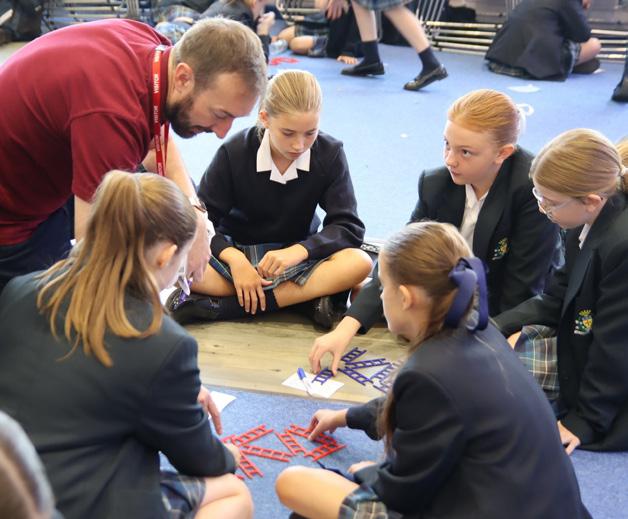
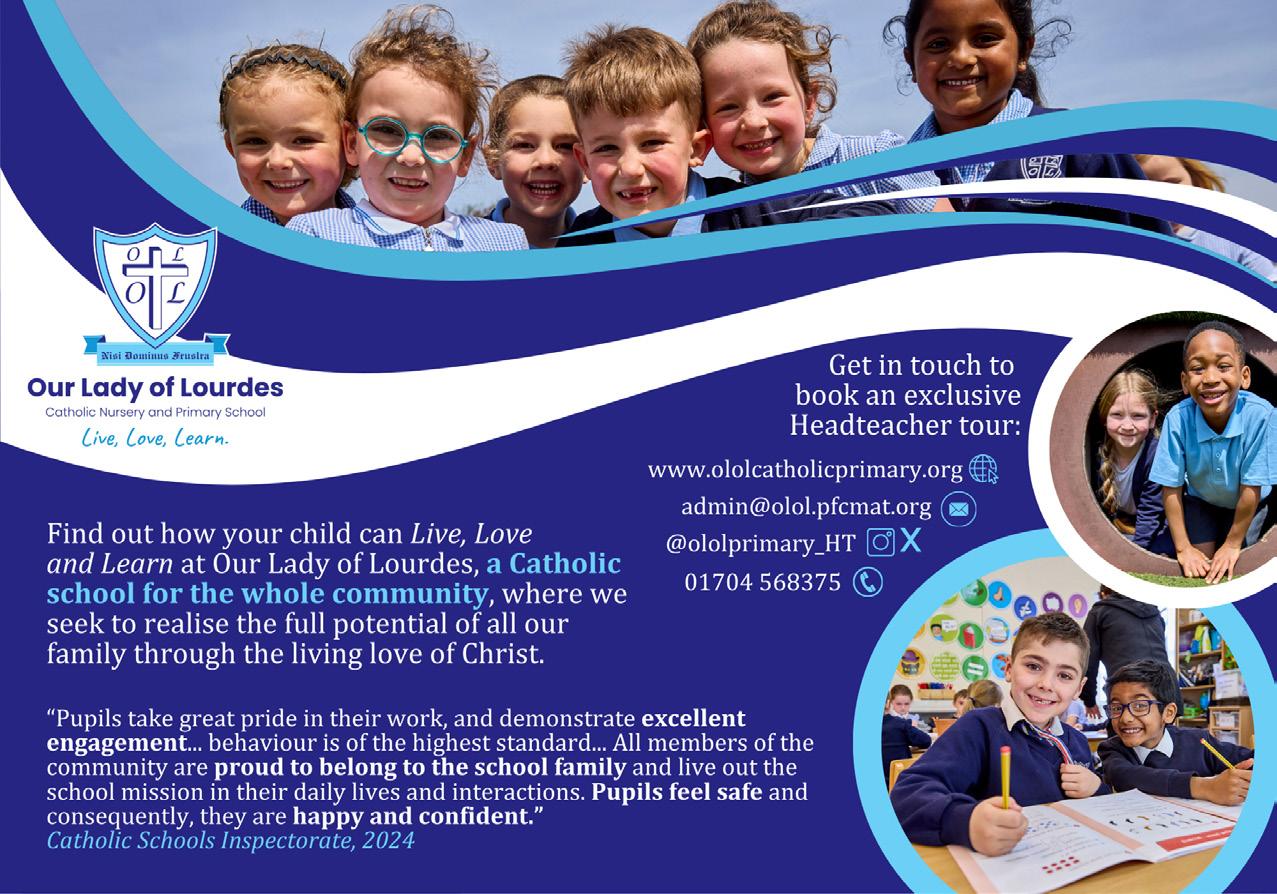
On 27 September, the Education Department held its first Headteacher Spirituality Day at the Metropolitan Cathedral. Planning was initially for a conference for our headteachers, but the idea of a day of spirituality and reflection quickly emerged, and the day took a new, important direction. Over 120 primary, secondary and sixth form headteachers attended the day.
Mindful that we are about to enter a Jubilee Year for the Church, the theme of the day was ‘Pilgrims of Hope’ and it seemed appropriate for us to be pilgrims for the day and hold the event at our cathedral. Two excellent keynote speakers enhanced the day and reminded us of the importance of our vocation and the mission of our schools. Sister Lynn Baron FCJ spoke of the role of the school in the faith community, and its relationship with the parish and the cathedral. Sister Judith Russi SSMN gave an address on Servant Leadership and the vital role of headteachers in inspiring other leaders. She reminded us that: “the future of humanity lies in the hands of those who are strong enough to provide coming generations with reasons for living and hoping.” – Gaudium et Spes – Second Vatican Council 1965.
One of the highlights of the day was the ‘Pilgrims Tour’ of the cathedral. Deacon Paul Mannings shared a fascinating insight into the history of the area and the story of the cathedral built on the site of a former workhouse. Colleagues were then invited to move around the cathedral in prayerful reflection, visiting the various chapels, listening to the reflections of the cathedral guides and joining in the prayers that were offered. A tour of the crypt and treasury followed, with many commenting that this was their first visit to this hugely impressive part of the cathedral.
It was a particular joy that Archbishop Malcolm celebrated Mass at the end of the day and commissioned our new headteachers. Along with Joan McCarthy, Director of Education, he presented them with certificates to mark the beginning of their headship. Feedback received from this day has been overwhelmingly positive and it is our intention to offer a similar days later this academic year for other senior leaders, governors, chaplains and RE leads. Thank you to Monsignor Anthony O’Brien, Claire Hanlon and the Cathedral staff for their welcome and hospitality.
Ben McMullen Deputy Director of
Education

The Trinity Catholic Academy, part of the St Joseph Catholic Multi Academy Trust, has received a glowing Catholic Schools Inspectorate Report, reflecting its outstanding commitment to education and community.
The report highlights the significant progress made under the leadership of the headteacher, who, with the support of the trust, has steered the school through a transformative period. “The headteacher, supported by the trust, has led the school through a period of much-needed change and transformation. The rapid pace of this has been handled skilfully,” the report praises.
The dedication of both the staff and the wider school community shines through in every aspect of school life. The report emphasises that “the staff at all levels are highly committed to the children and families in their care. They see themselves as one family and at the heart of the community.” This strong sense of unity and purpose is clearly reflected in the day-to-day running of the school, contributing to the remarkable success seen in both student engagement and wellbeing.
The exceptional behaviour of the pupils is another key area of recognition. “The behaviour of pupils is exemplary. Pupils are thoroughly engaged because expectations are high, teachers plan interesting lessons and build strong relationships,” the report notes. These positive relationships between staff and pupils foster a nurturing environment where children can thrive both academically and spiritually.
Parents, too, have expressed their trust and satisfaction with the school. The inspectors remarked that “parents know that their children are safe and cared for; children are very happy at this school.”
The school’s religious education lead also received special commendation, with the report stating: “The religious education lead is dedicated to her role and is a role model to her colleagues.” The report highlighted specific examples of the RE curriculum in action and the benefit on the pupils, “During religious education lessons, staff help the pupils grow morally and spiritually by reflecting on and helping to make sense of experiences from their everyday lives.”
This inspection report confirms that Trinity Catholic Academy continues to excel. It fosters a strong community spirit and delivers high-quality, faith-based education.
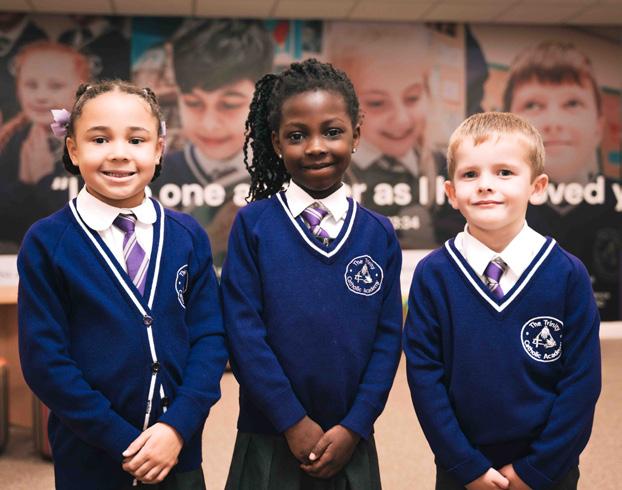
St Mary’s College in Crosby is a Catholic school for boys and girls of all faiths, where academic excellence and the fulfilment of potential are promoted within the context of a community of faith. The school is built on strong values which emphasise the importance of caring for others and always striving for excellence.
Staff at the school feel strongly that Catholic parents who opt for independent education should opt for Catholic independent education. The school’s catchment is wide and it does not take large numbers from any one parish or primary school.
St Mary’s College has its own bursaries scheme and each year the school is able to offer a number of Edmund Rice Scholarships (assisted places), which - according to financial need - may be worth close to full fees. This is in addition to several open academic scholarships awarded on academic merit alone irrespective of income. The school also awards scholarships for those gifted in art, music and sport.
The date for the St Mary’s College entrance examination for 2025 entry into Year 7 is Friday 15 November 2024, with interviews taking place earlier that week (w/c Monday 11 November) and art, music and sport scholarship assessments taking place the previous week (w/c Monday 4 November).
To register your child for the St Mary’s College entrance examination, please download an application pack from the St Mary’s College website: www.stmarys.ac/admissions

Sacred Heart Catholic Academy had a phenomenal afternoon in October competing to attempt a world record with its local primary school partners.
Pope Francis Catholic Multi Academy Trust was delighted to hear that 433 participants took part in attempting the world record for the most origami hearts ever made together in one room. This exceeded the previous number of participants, which was 352.
Origami is the Japanese art of paper folding, and the practice has attracted a worldwide following. The goal is to transform a flat square sheet of paper into a finished sculpture through folding and sculpting techniques.
As Sacred Heart’s Heartbeat Challenge began, students learned about how their heart works and how they can keep it healthy. Staff were delighted to see everyone’s excitement at the video messages of good luck they received from international world record holders in football, swimming and film.
The trust is grateful to all participants from the schools that took part in the fantastic, memorable event.
Readers are encouraged to keep an eye on Sacred Heart’s website and social media accounts for news and videos of all its wonderful record makers.
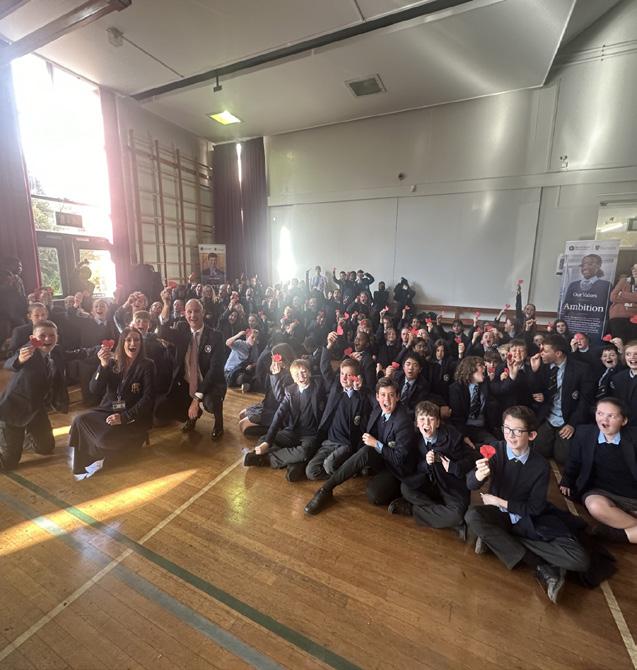
The Academy of St Francis of Assisi recently celebrated the feast day of its patron saint, St Francis of Assisi, with a wholeschool event dedicated to the theme of kindness to animals.
St Francis of Assisi is the patron saint of animals, and the day highlighted the values of stewardship, kindness, and respect for all of God’s creation, which he championed throughout his life.
The morning began with a special pupil-led Collective Worship in assembly. Students shared reflections on St Francis’ remarkable life, emphasising his deep love for animals and the environment. The assembly was a moving tribute to St Francis’ teachings, inspiring all students to follow in his footsteps. A highlight was watching the annual blessing of the animals at New York’s Cathedral, connecting the students with global celebrations of this beloved saint.
During form time, students participated in reflective discussions on how St Francis continues to inspire them to care for creation. As part of the day’s activities, the school also launched the ‘What would Francis do?’ campaign. The campaign displayed powerful images of animals affected by environmental harm, sparking important debates around the role of humans as stewards of the earth.
One of the most exciting parts of the day was a visit from a local animal display company. Year 7 students, as well as staff, had the unique opportunity to interact with an array of animals including snakes, lizards, meerkats, and birds of prey. For many, it was a chance to learn about these fascinating creatures, while others even conquered their fears of snakes or lizards!
The day also included a raffle in support of the RSPCA. The raffle’s top prize, a giant sloth teddy affectionately named Sid by students, helped raise over £100 for the charity.

Headteacher of the academy, Ms Jo Leech, commented: “St Francis’ Feast Day is always a special occasion for us, but this year’s focus on animal kindness really captured the essence of our patron saint’s values. The hands-on experience with the animals was not only educational but also brought to life St Francis’ teachings about respect and care for all living creatures.
“I’m incredibly proud of our students for embracing the spirit of the day and for their efforts in raising money for the RSPCA. This celebration reminds us all of the importance of being stewards of God’s creation.”



St John Bosco Arts College in Croxteth is thrilled after receiving an ‘outstanding’ rating from the Catholic Schools Inspectorate following its recent school inspection.
The Catholic Inspectorate assesses schools across three categories: Catholic life and mission, religious education and collective worship.
According to the report, the Salesian principles of respect, understanding, affection and humour are at the heart of all the schools does; ensuring that Christ is at the centre of its work.
The report also praised senior leaders and the chaplaincy team for being ‘outstanding role models’, noting how their passion ensures that the school’s Catholic life and mission are vibrant and relevant to all community members.
Students spoke passionately about the influence and exceptional work of the school’s chaplain, Anne Quirk, who is highly regarded and seen as the ‘head of the family’; and loved by all.
Inspectors highlighted how all staff and students exemplify the school’s mission statement: ‘Together we inspire each other to flourish in Faith, Hope and Love’ which, consequently, makes students feel happy and safe, resulting in a calm and purposeful feeling throughout the school.
The school’s commitment to fostering a community built on faith, hope and love is echoed in its work with local organisations, where staff and students participate in charitable activities and events for local food banks, CAFOD and Macmillan Cancer Support.
Pastoral care was described as ‘second to none’ with the school focusing on supporting the most vulnerable in their community. The report stated: “Consequently, all students, regardless of their background, faith or culture, feel appreciated and show respect to each other and to adults.”
Inspectors highlighted how leaders and governors show all staff dignity, respect and appreciation of the value of their work. Staff commitment is a testament to the supportive culture that is embedded across the whole school.
St John Bosco staff were applauded for ‘strong subject knowledge and demonstrating a deep commitment to communicating the value of religious education’ by inspectors. This commitment is evident through students’ enjoyment and appreciation for religious education, which ensures they can explore their own faith and prepare for life in a multi-faith society.
The report also highlighted how Key Stage 5 religious education outcomes are strong and outperform all other subjects in the school.
St John Bosco was awarded an ‘outstanding’ grade for prayer and liturgy, with the report detailing how this is a focal point of school life, with all students benefitting from this, regardless of faith.
Inspectors also noted how prayer and liturgy activities promote participation and are thought-provoking. “Students demonstrate ‘confidence and flair’ and appreciate the importance of the opportunities to reflect on moments of prayer,” Inspectors said.
Discussions with students illustrated that they can identify links between their experiences in prayer and the school curriculum. One Year 10 student described prayer ‘as an affirmation of each person at the beginning of the school day’.
Prayer and liturgy were described by inspectors as ‘paramount at St John Bosco’ with a multitude of ways to pray, stretching beyond traditional methods, available for all students.
Staff have a deep understanding of each student which enables them to ‘skilfully integrate their gifts and talents into prayer and liturgy’.
Anne Quirk, the school chaplain, shared her joy in the report outcome. Anne said: “We are extremely proud to have been awarded ‘outstanding’ from the Catholic Schools Inspectorate.
“Our Salesian principles are the cornerstone of our school community, and we aim to support our students to embody those principles through their own faith.”
Mrs Danielle Tomkins, head of religious education and Catholic life at St John Bosco, said: “We are immensely proud that our school’s continued commitment to developing a supportive and nurturing learning environment built on faith has been recognised by the Catholic Schools Inspectorate.
“We are continuously seeking new ways to excite, engage and encourage our students to deepen their faith in their own way.”
Commenting on the report, headteacher at St John Bosco Arts College, Mr Darren Gidman, said: “We are elated that we have received an overall ‘outstanding’ rating from the Archdiocesan inspectors.
“At St John Bosco Arts College, we are committed to fostering a learning environment where students are supported to flourish through faith, hope, and love.
“We are delighted that inspectors recognised our commitment to ensuring Catholic life and teachings are embedded in every aspect of school life.”

By Ellie Leatherbarrow, Animate Youth Ministries
We have started back at Animate after the summer holidays –and we are certainly right back in full swing. With the launch of the Faith in Action award, the Lourdes applications going live and the beginning of our day retreats, it is safe to say it has been a busy start.


The start of the new academic year is always very fast-paced, but it is so great to work with so many different people, and also to see pupils we have worked with before. Seeing these young people that we first met when they were in Year six and how they have progressed to high school is always a highlight of mine. It is good to see how they have settled into their new schools, making new friends and trying new things. You can see how you may have impacted them individually on their journey.
So far, we have worked with a few high schools and in light of the jubilee year coming up in 2025, chaplains are wanting us to explore the theme of ‘Pilgrims of Hope’. For this, we have come up with a day retreat that focuses on the logo and how we are able to use the different parts of the logo to live out the jubilee theme.
How we explain the different parts of the logo is by stripping it right back and starting with just the logo’s outline. The first aspect we look at is the figures in black and white and how they are leading on from one another. To highlight this, we do an activity called ‘Crystal Maze’. This involves lots
of different activities around the house; the young people have to work together and just as the logo symbolises humanity as a whole, they proceed to embrace each other and walk forward united as a group.
We then do an activity called ‘Egg Drop’ where the youngsters get resources to create something to protect an egg that will be dropped from the roof. The idea behind this is that it will introduce the colours of the different characters on the logo and how they are all different – just like we are all different and each have our own unique gifts and talents.
The third part of the logo is the wave, and for this, we give the young people different challenges that they must complete. This is to symbolise the existence of dangers and obstacles of those personal events and events of the world that make each of our lives not always easy.
The sense of the anchor in the logo shows us in the most difficult moments we need to rely on an anchor that gives us security, and that anchor is faith. To look at this, we present the group with different situations and ask them what they would do in these scenarios and see how they would be guided by their different morals.
To end the day, we add the cross to the logo to highlight our faith and how the cross is not rigid but bends towards humanity as if to embrace it. Overall, it has been great to learn about the meaning of the different symbols of the logo and to highlight the importance of the upcoming jubilee year for all of us.

Ladies, I can’t believe most of us are not long back at our foundations after the summer break but have already managed to do so much.
To give you the example of St Margaret Mary’s, they began with a coffee evening to raise money for Macmillan Cancer Support and by baking some lovely cakes to sell, they raised £170.
The following week, there was a talk from a group of volunteers from The Bloom Appeal (Merseyside against Blood Cancers). They talked about the different varieties of blood cancer and how their organisation, founded in 2014, helped to support the care and well-being of patients as well as their families. There was a tombola and lots of gifts for us to buy, including some beautifully knitted baby clothes, and £200 was raised for this charity.
A week later, Father Roy Cooper celebrated Mass for five ladies who had reached the milestone of 50 years as members of the Union of Catholic Mothers. The five are: Catherine Simpson, Angela Batey, Mary Pearson, Margaret McDonald and Catherine McCormack, and they are pictured in the photo, from left to right, along with Maureen Finnegan, Fr Roy and Madeleine McDonald.
This is a wonderful achievement for them and for St Margaret Mary’s, whose UCM foundation dates back to 1934. After Mass, the celebration continued with tea and strawberry scones.
I wonder if any other of our foundations have been so busy this autumn –please let me know as I am sure all our members would like to read about it.

• Our next bi-monthly Mass is at St Aidan’s on Tuesday 12 November.
• To learn more about The Bloom Appeal, visit: thebloomappeal.org.uk
Maria Pimblett, Media Officer
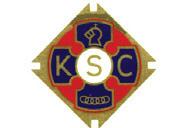
As I write this report, our own province – Province 2 – is busy working with the Supreme Council of the KSC, arranging the 102nd Supreme Council Meeting which we are hosting on the weekend of 18-20 October at the Liner Hotel in Liverpool.
By the time you read this, brothers from all over England, Scotland, Wales and the Channel Islands will have been joined by brothers from Ireland – the Knights of St Columbanus – and other esteemed guests including Bishop Tom Neylon, our ecclesiastical adviser, and members of the clergy from across the country.
News from the councils
Together, they will have participated in formal council sessions where matters affecting the Knights locally, regionally and nationally are discussed; the Jack McArdle lecture by Canon Luiz Ruscillo, provincial chaplain for Province 6, Cumbria; a gala dinner on Saturday evening; and Masses on Saturday and Sunday morning, along with the installation of the new supreme directors.
It is a great honour for our province to host this event and a huge thank you is due to all the brothers who have volunteered their help and support. A further update will follow in the next edition.
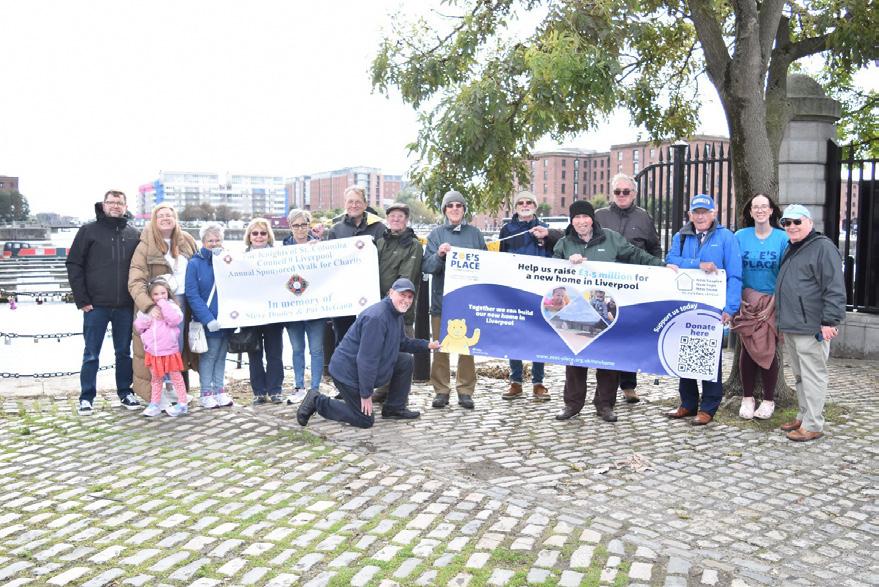
• Annual Sponsored Walk in Memory of Steve Dooley and Pat McGann
Council 9 members recently completed their annual sponsored walk, raising much-needed funds for the Zoe’s Place Baby Hospice, which is looking to build a new home in Liverpool. They are trying to raise £3.5million to achieve their goal and to support them, you can donate via www.zoes-place.org.uk/save-ourliverpool-hospice.
• Southport Knights’ centenary plans Council 146 is looking forward to a year of celebrations in 2025 to mark 100 years in the service of the people of Southport. Events will include a garden party and a gala dinner as well as the creation of a formal register of all brothers who have served the council during the past century.
To find out more about the KSC or arrange a visit to your local council meeting, please contact Philonline2@btinternet.com Phil Woods, Provincial Publicity Officer
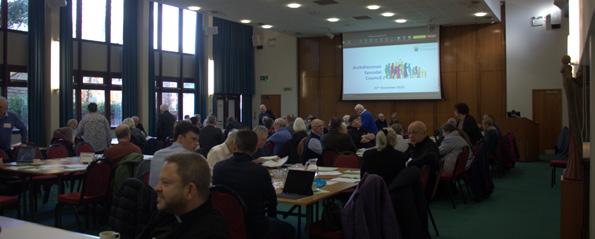
Advent 2024 sees the third anniversary of the proclamation of the post-Synod Archdiocesan Pastoral Plan.
This is a good time to review what has happened, what has been done and what is still to do.
One of the ways this was done was in a recent gathering at St Margaret Clitherow Centre of the Trustees, the Archbishop’s Advisory Body, the Executive of the Archdiocesan Synodal Council and archdiocesan staff. This took place on Friday 27 September and was led by a facilitator (Alastair Callaghan) from the Kinharvie Institute.
The day began with Fr Peter McGrail taking the participants through the Pastoral Plan. This was a most timely reminder of the main principles that underpin the whole plan: in the plan, they are the four signposts:
1. Be immersed in the joys and hopes, griefs and anxieties of humanity today.
2. Develop leadership to attend to changing needs
3. Be bold and creative in renewing local structures
4. Embed synodality in every aspect of archdiocesan life.
Having looked at these the 42 participants broke into groups to look at the six development areas of the plan. This was done in order to see what needs to be done to make the aspiration and desires of the Plan more of a reality.
This has led to six strategic actions for the archdiocese in the year ahead. These will form the main item of discernment and listening for the Archdiocesan Synodal Council, which meets on Saturday 9 November.
You are invited to share in the first part of the ASC via Zoom on 10.30am – 11.30am on 9 November. If you would like to join, please email catholicpic@rcaol.org.uk for the Zoom link.
STRATEGIC ACTIONS to be discussed by the Archdiocesan Synodal Council.
Area 1
Set up a multi-agency group to develop a strategy for engaging all areas of archdiocesan life with the accompaniment approach. Engage again with the Million Minutes Proximity Project (a national group looking at accompaniment) and any other accompaniment models already existing.
Area 2
Working with Area 1 (accompaniment) we will explore how we can reaffirm the universal call to holiness; focusing on one designated area of life.
Bring together all those who have been through the Loyola Course and the learning from the Pastoral Associates Pilot Project to bring forth a document that can inform progress towards employment of lay ministers at local level and outline the steps needed in recruitment, formation and training to further develop collaboration between lay and clerical ministry.
Area 3
Set up a pilot project to bring together archdiocesan staff, governance, clergy and people to understand and begin training in synodal working and develop practical proposals as to how it can be embedded. Explore the implications of having experienced a synodal way of working and see how it can influence all areas of archdiocesan life ensuring that prayer is always a significant starting point at archdiocesan meetings.
Area 4
Led by the deans, look at the buildings and resources we have and create an archdiocesan wide conversation about the future use of these – guided by a set of agreed criteria, that helps us develop our sense of mission. This will make use of data gathering systems. We will develop a model and template so that each deanery can engage with this.
Area5
Ensure that the youth post is recruited with an emphasis on the new postholder establishing the Youth Council so that the voice of young people can be taken account of.
Find ways of linking with the Bon Secours Young Adult project. Develop the possibilities for chaplaincy opening in the CMAT’s. (Catholic Multi Academy Trusts.)
Area 6
Develop ways of supporting clergy during a time of change with key concern for their wellbeing and the development of a purposeful ongoing formation program that meets current needs - training for some clergy in managing change and support the change process in each deanery.
By Ultan Russell, Archdiocesan Ecumenical Officer

Further proof that the ‘Merseyside Miracle’ continues was manifested in the close bonds between our own dean at the Metropolitan Cathedral, Monsignor Provost Tony O’Brien, and his fellow dean from the Anglican Cathedral, the Very Reverend Dr Sue Jones. So Liverpool still enables joyous and unique things to happen when, at times, we can feel ecumenically in the doldrums.
It was an immense joy to welcome the Apostolic Nuncio to Great Britain, who has now visited our Co-Cathedral on the Isle of Man, as well as our sister Cathedral at the other end of Hope Street. We must get him to come to the Met before long!
A passionate ecumenist born in South Africa in 1953, Professor Gerald Pillay spent his early life in the era of apartheid, and creating partnerships has been pivotal to his life and work. Coming to Liverpool in 2003 – as rector of the then Liverpool Hope University College – was a natural progression of his deep faith, ambitious standards in higher education and his vision for ecumenism. He arrived here from the University of Otago in New Zealand and his impact was swift: following tremendous work on his part, Hope became Liverpool Hope University in 2005, and he then became vice-chancellor.
His commitment to sustainability was mirrored in the efforts to create a beautiful campus at Hope Park in Childwall and the Creative Campus in Everton. He sought to make it accessible too, enabling Liverpool Hope to be a positive, welcoming environment for students with disabilities.
In addition, his passion for justice and peace was mirrored in the creation of the Tutu Centre focused on Peace Studies and his support for many Christian Higher Educational institutions
around the globe, notably Bethlehem University (run by the De La Salle Brothers). Rev Canon Cynthia Dowdle, chaplain emeritus of Liverpool Hope, said of him: “Gerald Pillay’s Christian faith shone through in all that he did and the fostering of many international partnerships with universities and colleges was significant.”
In addition, he forged the international Hope Ecumenical Network, which brings together chaplains and a range of academics from many of Liverpool Hope’s twin colleges/universities. Another of the partnerships he fostered was with the Catholic University of the Rhine Palatinate, with a key centre in our twin city of Cologne. By joyful coincidence, in October our two cathedrals welcomed the choir of Cologne Cathedral – another ecumenical link. Monsignor John Devine spoke movingly during the investiture of Professor Pillay’s generosity and creativity and the fact he became the first vice-chancellor of a British university from an ethnic-minority background. When the Papal Nuncio handed over the scroll and medal, it was a joy to see him with the archbishop on one side of him and Bishop John on the other – one of many memories of a unique event.
The Knighthood of St Gregory adds to other honours that he has received including serving as a Deputy Lord Lieutenant of Merseyside and, in 2022, the Order of the British Empire (OBE).
Finally, the Evensong service was beautifully prepared and delivered with another ecumenical gift: namely Stephen Mannings, Liverpool Cathedral’s director of music, who was also active in welcoming the Cologne choristers in October. Stephen (as many of you will know) is the son of Deacon Paul Mannings and the ecumenical links continue as he is married to Rev Kim Mannings, the Vicar of Prescot.



